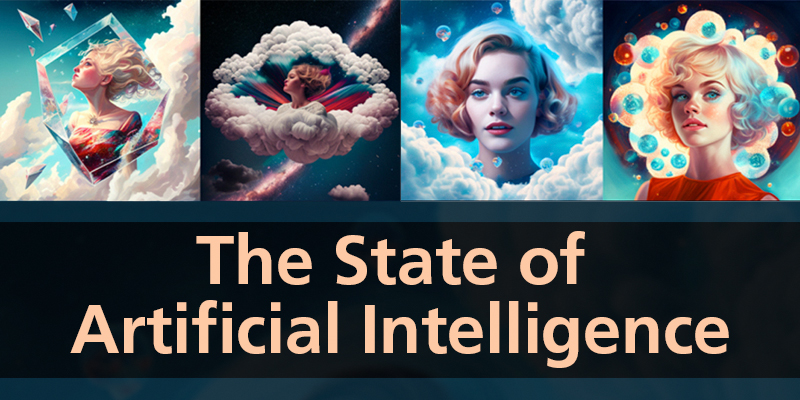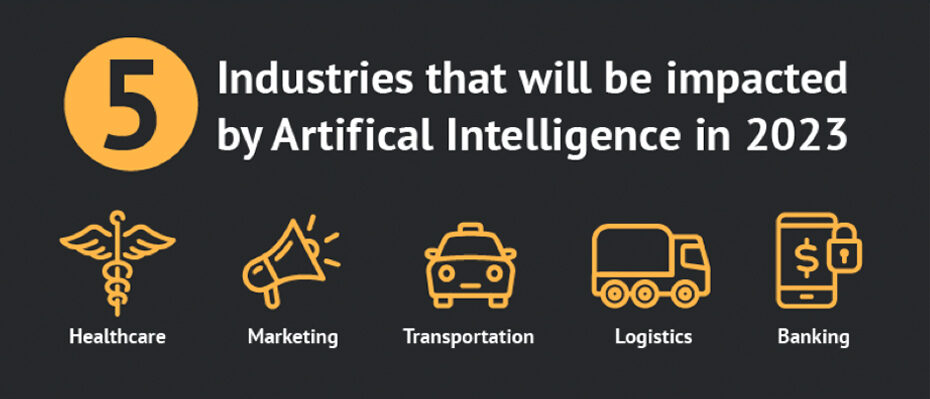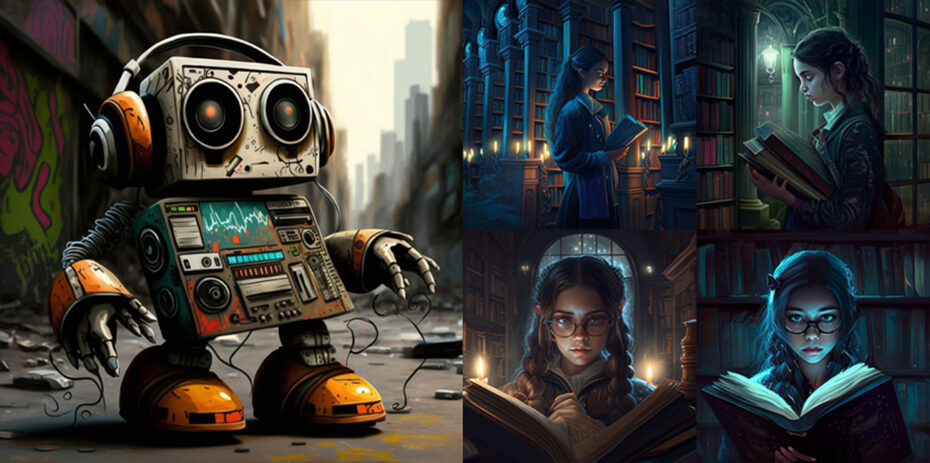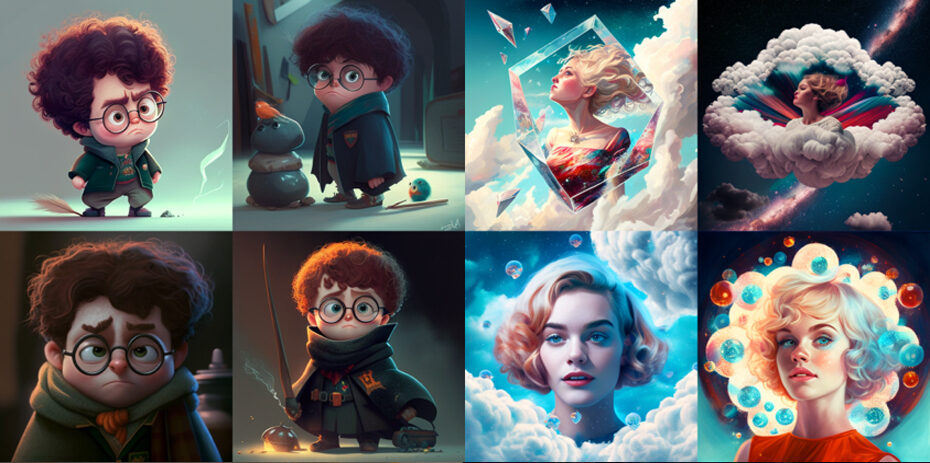
The State of Artificial Intelligence
The growth of artificial intelligence, or AI, has sparked both excitement and controversy. It’s already suggesting songs you may like on Spotify and books you may want to read on Amazon, operating self-driving cars and even winning art competitions. We’re expecting 2023 to be a huge year for the field.
What is AI?
Artificial intelligence (AI) refers to complex software that simulates human intelligence and performs tasks in a way similar to human brains. Things such as chatbots like ChatGPT, virtual assistants like Alexa and Siri, and image generation websites like Stable Diffusion all use AI to respond to user input to perform tasks, and they continue to mature and evolve.
How does it work?

Artificial intelligence works by inputting data into an AI system in the form of text, speech, images, video, etc. It processes and interprets that data using machine learning combined with advanced algorithms to learn from the patterns or features in the data. It continues to get smarter each time it processes a round of data by testing and measuring its own performance and making adjustments.
How is AI impacting the creative industries?
In the past decade, AI has continued to expand its role in the creative industries. AI can now generate realistic images just from text prompts within minutes, edit and enhance selfies, remove the background from videos, create 3D assets from prompts, among much more.
In 2022, an AI-generated artwork won first place in the Colorado State Fair’s fine arts competition, leaving many creatives to wonder if AI is threatening their work. While AI may change jobs, it’s more likely to play a supporting role as a collaborator rather than a competitor. AI and creativity are opposite concepts. AI is all about precision and accuracy, while creativity is all about coming up with new and unique solutions.
Benefits of AI for the creative industry:
Streamline processes
Can help with repetitive tasks
Making creatives think differently and coming up with new solutions using this technology
Reduces potential for human error
May help create jobs
Risks of AI for the creative industry are:
AI imitation, such as voice cloning which can replicate a human voice with only a few seconds of sample to work from (music industry)
Clients opting for the easy, quick, cheap way of getting art using online AI sites, rather than paying for a service
Relying too much on AI tools and losing the creative edge
Can change job responsibilities
What does the future hold for Illustration? Will illustrators be adversely affected by the impact of AI?
AI has made a huge leap in the art industry. Quick and inexpensive art without having to sacrifice quality? While it could sound scary, the cause for concern shouldn’t weigh too heavily on the future of illustration.
While contemporary illustrators may be influenced by the impact of AI, they are likely to incorporate it into their workflows, rather than let it replace their human-created art. The generated art can be super realistic and accurate, but AI art needs the input from a human to choose the subject and its surroundings for producing the desired results. Also, without real human interaction, providing feedback and implementing it isn’t possible.
A common critique of AI-generated images is that they all seem to have a similar look to them. This is a good opportunity for artists who want to express their unique visions and differentiate themselves to really shine as they can still produce something truly unique. Originality, personality and creativity is what makes artwork great, and that is something AI cannot replace.
How can this technology be used as a tool rather than an end in itself?
AI can help enhance the creative process, but ultimately humans will still be needed for developing ideas, giving instructions and revising and editing as needed. User experience will be a key differentiator when it goes to using AI as an effective tool. Here are some ways to use this technology can be an assistant to your work:
It can help increase productivity and creativity
It can automate simple or repetitive tasks
It can assist in large volumes of work
It’s great for brainstorming and sharing ideas
It can help creatives start thinking in different ways how they can use this technology to create new things
Which industries will be impacted the most?
It’s 2023, you’re calling your doctor’s office to schedule an appointment, you speak with the receptionist…only to later find out you didn’t speak to a human being at all! AI can now believably impersonate humans on phone calls to schedule appointments 🤯
With the rapid advances in AI, combined with advances in data analytics and machine learning, it could totally transform how businesses operate. Its deep learning capabilities can have a drastic change on how specific sectors manage their operations. While it can be disruptive to these industries, it also has positive effects such as increased efficiency and profits for companies.

From healthcare to transportation to banking, here are five industries that are likely to be disrupted the most:
Healthcare
Healthcare providers save money using AI for simple tasks such as data entry and scheduling. With AI, gathering valuable patient information is easier and providers will be able to make more informed decisions and provide better treatments to patients. Other huge highlights within industry include robotic surgery, analysis of medical images, and predictive healthcare which could help anticipate and address potential health issues before they become serious.
Marketing
Automated data entry and lead generation, that’s just the beginning for AI in the marketing industry. AI can be used to anticipate customer behavior, target campaigns more accurately, create tailored ads, and automate the writing process and optimization of content. Businesses can reach more customers, drive more conversions, free up marketers time, and best of all, have a significant increase in their ROI. While those are all great, it does put marketers at risk of finding themselves more reliant on AI technology to do their jobs, making the job more about data and algorithms and less about strategy and creativity.
Transportation
Did you know that self-driving taxis are available in Phoenix, AZ? And in Texas, Walmart and Ikea are trialing driverless truck deliveries! Aside from totally revolutionizing the transportation industry, the technology of autonomous driving is also expected to significantly reduce traffic accidents in the future. Other tasks in this industry are being automated through AI such as optimizing routes, traffic forecasting, anticipating peak hours, offering alternative routes and improving customer service.
Logistics
In the logistics industry, AI is already used for the automation of the more mundane tasks such as load planning, monitoring shipments and delivery schedules, and optimizing routes. By leveraging AI’s predictive analysis, businesses will be able to more accurately forecast inventory needs and anticipate customer demand. With image recognition, the process of sorting and packing goods can be automated and streamlined, while also reducing the risk of human error.
Banking
AI is already being used for fraud detection and customer service automation. In the future, AI can be used for data collection, paperwork and document processing, and predictive analysis about customer behavior and fluctuations in the market, giving banks a competitive edge. Banks will be able to provide better services as they will be able to more accurately anticipate their needs.
How are artists using this tech in their current workflows?
Some of the ways artists are using AI in their work are:
For brainstorming and exploration
Idea generation
Mood boards
Automatic captioning
Audio and video clean-up
Character design
Image generation using text-to-image prompts
Music composition
Using it as a concept art tool by generating different poses, lights, compositions, etc.
For fixing and enhancing areas of their art
Using AI-generated imagery as references for their art or incorporating them into their design
Most popular sites and apps for AI image creation.
AI Sites
AI sites, such as Stable Diffusion, Dall-E, and Midjourney have really taken off over the past year. Typing in just a few words into a prompt on these sites will generate a super detailed and high-quality AI image. These sites have been fed billions of images from the internet until they “learned” to associate certain words and concepts with certain imagery, in turn creating stunning illustrations in as little as minutes.
My first try at using one of these AI sites was a big surprise. It was so easy! I tried out the program Midjourney. After a quick sign up session, I easily found my way around the site to a chat where I was able to start “creating” some illustrations. Within 25 minutes I had created 7 different illustrations using their /imagine input. Within minutes, a graffiti radio robot was walking the streets, a book I read last summer called The Midnight Library now had a main character and a library scene, Harry Potter is now a Pixar-style character, and the song “Lucy in the Sky With Diamonds” now has a face to it. All generated just by typing a few words into a prompt.


Midjourney (midjourney.com)
Stable Diffusion (stablediffusionweb.com)
Released in 2022, Stable Diffusion is a deep learning, text-to-image model that is primarily used for generating detailed, high-quality images based on text inputs.
Dall-E (openai.com)
One of the earlier deep learning models, revealed in January of 2021, Dall-E can generate imagery in multiple styles, ranging from photorealistic imagery to paintings, and even emoji. Dall-E’s developer OpenAI took the next step in November 2022 by releasing Dall-E 2 as an API, which is allowing developers to integrate the model into their own applications. Some of the early adopters of Dall-E 2 have been Microsoft, CALA and Mixtiles.
AI Apps
Perhaps you’ve noticed your friends on social media have been uploading ai-generated selfies? Most likely they’ve been toying around with Lensa, the viral photo-editing app that takes your uploaded photos and creates “magic avatars” using your face. Alongside Lensa, AI image apps are also on the rise. Some AI photo editing apps to check out are YouCam Perfect, FacePlay, Remini and Voila.
Lensa
One of the most popular apps at the moment, Lensa offers a variety of tools to edit photos and video in real time—meaning you can make changes on the fly without the render time. The “Magic Avatars” feature offers users a way to create a series of AI selfies from their own photo collection.
YouCam Perfect
Looking for a way to automatically enhance or edit your photos in just a few taps? The YouCam Perfect app can instantly improve the look and feel of your photos by adjusting parameters such as contrast and brightness, “beautify” your portraits, and help you quickly delete unwanted objects, text or people from a photo background.
FacePlay
This AI video and photo-editing app that lets users seamlessly insert their face (or someone elses) into all kinds of photos and short videos in just seconds.
Remini
Have low-quality or pixelated looking images? Remini is great for taking your low-resolutions photos and raising their overall quality.
Voila
For a fun take on AI apps, turn to Voila! You can use this app for turning your photos into fun cartoons or even paintings from any century.
Conclusion
AI is transforming the way that our world runs, and the future is wide open for how it will continue to impact us as it continues to grow and advance.


There are no comments so far